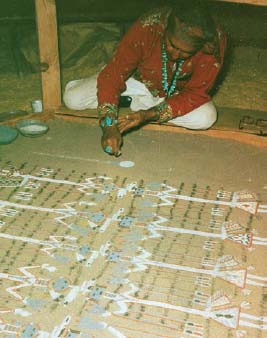The Modern World During and After the World Wars, C. 1914–1960Native American Art |
What is a Navajo sand painting? |
Sand painting is an essential part of traditional healing ceremonies for the Native American Navajo people of the American southwest. Using natural materials such as colorful powdered stones, pigments, and even corn pollen, Navajo medicine men ritualistically recreate the mythological journeys of gods and heroes to form complex images with healing powers. Najavo sand paintings, also called dry paintings, are often composed of highly stylized, repetitive geometric forms such as curved and angled lines. Completed paintings are never publicly shared and they are destroyed once the ceremony is over, though some sand painting imagery has been published and photographs are owned by the Library of Congress and other institutions. Strict adherence to ritual tradition is necessarily in order for the healing ceremony to be successful. The American abstract Expressionist artist, Jackson Pollock, was inspired by the process of creating the sand painting, which is laid flat on the ground while the artist stands over it— a process Pollock used when making his own art.

The sand painting techniques used by Navajo Indians emphasize the importance of the process of creation. Paintings are created according to ceremonial tradition and finished works are not publicly shared. (Art courtesy Arizona, USA / Peter Newark American Pictures / The Bridgeman Art Library.)
